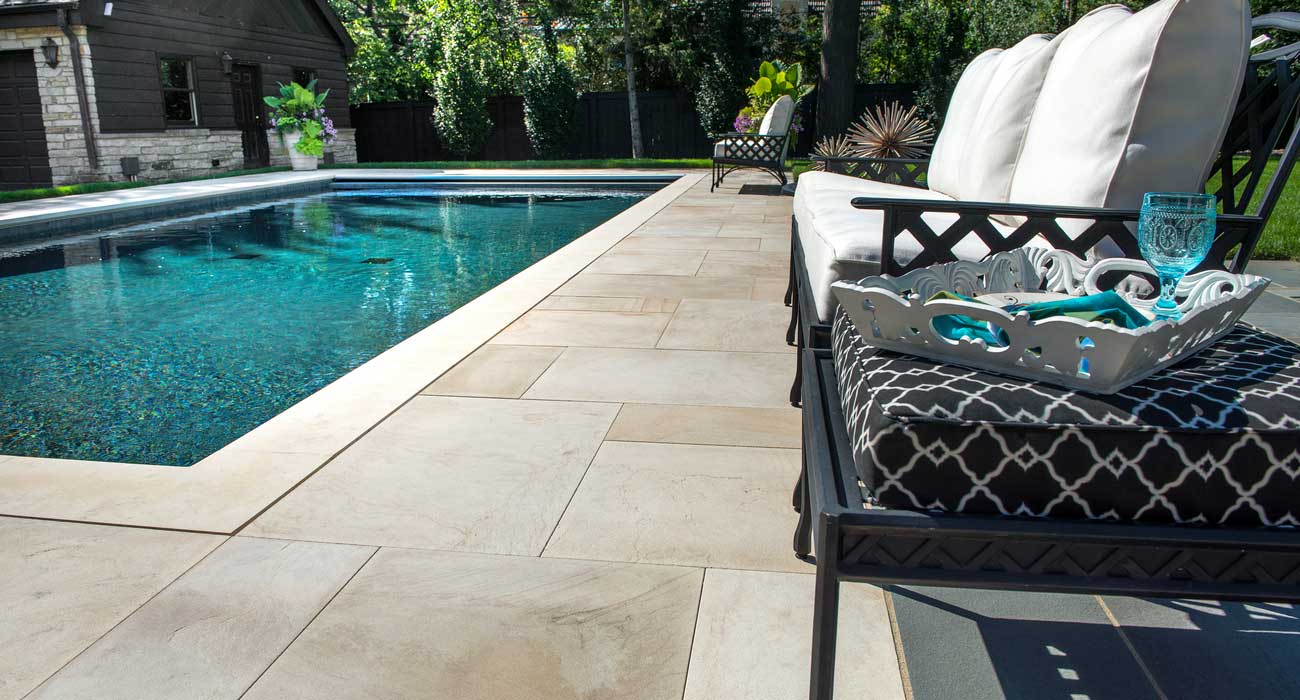Our friends at Unilock have written an excellent article detailing key considerations when designing an inground pool deck. We’re excited to share this resource with you, as it offers expert insights to help you design a functional and beautiful pool deck that enhances your backyard and provides a safe, enjoyable environment for swimming and relaxation.
An in-ground pool greatly expands the enjoyment potential of your backyard. Nothing is more inviting than that glistening water on a hot summer day. But what about the deck surrounding your pool?
Aesthetically, the decking defines your refreshing oasis. It can enhance your landscaping, and effectively tie in other elements such as a fire pit and pathways. From a practical standpoint, pool decking provides a safe, comfortable walking area for swimmers, as well as a place for poolside loungers.
If you’re adding a deck around your inground pool, consider these commonly asked questions before you begin.
What is the best decking for a pool?
The best decking product for a pool is pavers from Unilock, which are engineered to provide a safe grip – even when wet, and to stay cooler in the hot sun. Choose from these popular Unilock products:
Umbriano – The unique, mottled surface with granite particles gives Umbriano anatural, non-slip texture making it a popular choice for pool decks.
Beacon Hill Smooth – With extra-large sizes and a contemporary color palette including lighter colors, which help keep your deck cool on the feet, Beacon Hill Smooth creates a sleek, modern pool surround.
Arcana – Arcana’s large format pavers have a silky, matte texture and speckled appearance of natural granite, quartz and marble particles for a stunning surface that also provides a safe grip for wet foot traffic.
What is the best material for pool coping?
When selecting material for pool coping, natural stone products such as Ledgestone,Granite and Limestone are the best choices. Not only does natural stone coping add a touch of elegance to your pool deck, it is also cool to the touch, durable and strong, and has low water absorption.
Pool coping is the protective lip or cap at the top of the pool wall that finishes off the look. Coping has other purposes
such as keeping debris from entering your pool, helping swimmers enter and exit the pool safely and reducing the risk of slipping around the pool edge.
What is the coolest pool deck surface?
The coolest pool deck surface is made from pavers. Swimmers commonly have bare feet when walking around the pool area, and a paver deck will allow them to walk safely on a deck that provides a good grip and is pleasantly cool for tender tootsies.
When considering pavers, look for a product that is light in color such as Umbriano Summer Wheat or Winter Marvel. Umbriano stays cool, and has a natural, non-slip texture thanks to the unique mottled surface with granite particles. Be sure to complement your decking with a light, natural-colored coping material as well.
Are pavers or concrete better for pool decking?
While poured concrete is commonly used around inground pools, pavers are a better option for pool decking – when installed properly.
Concrete is more likely to crack, which can be costly to repair. A large area around the damage must be professionally cut, removed and concrete must be re-poured, which can be very disruptive. Moreover, if your concrete is colored, the color will fade over time, making color-matching difficult – if not impossible.
Pavers come in many colors and patterns offering more creative options. They are designed to hold up well over time, even tolerating harsh freeze/thaw cycles. If a stone needs to be replaced, it’s as simple as removing it and replacing it with a new matching stone from the same line. Pavers are also unaffected by chlorine and other pool chemicals.
Do pavers get hotter than concrete?
Both pavers and concrete will get hot from the sun. That’s why it is advisable to choose pavers in lighter shades. Light-colored pavers won’t absorb the sun’s ray, and they will stay much cooler to the touch.
Which lasts longer: concrete or pavers?
Typically, pavers last longer than concrete because they are less susceptible to damage from ice, winter heaving and salt. Pavers are also 2.5 times stronger than poured concrete.
Concrete often fades or chips away with time, especially in cold climates. When the temperatures drop to below freezing, moisture in the concrete can expand, creating pressure and damaging the surface layer, which can look unsightly over the years.
Is it cheaper to pour concrete or use pavers?
Plain poured concrete is cheaper than pavers because it is exactly that – plain. It has no color, no texture, and no real aesthetic value.
How much does it cost to put pavers around a pool?
To put pavers around a pool typically starts at approximately $20 per square foot installed. However, that cost can be affected by factors such as property access, excavation requirements, retaining requirements, paver type and your deck design.
We hope you found this article from Unilock both informative and helpful. If you’re interested in Unilock products or other landscaping, masonry, and stone products, we invite you to explore our Products page. For further assistance, please feel free to Call, Message, or Visit Us today. Our team is always ready to help you find the perfect solutions for your outdoor projects and ensure you achieve the best possible results.


